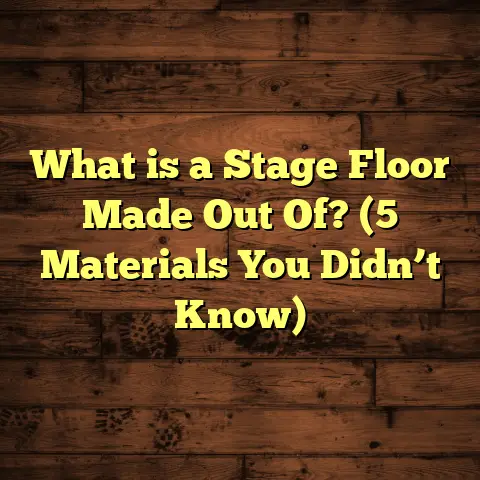What is a Concrete Floor Made Of? (5 Key Ingredients Explained)
Imagine you’re standing in a freshly poured basement or workshop floor. The surface feels solid and cool beneath your feet, but have you ever wondered what exactly makes up that concrete floor? What gives it that incredible strength, durability, and longevity? Having worked in the flooring industry for many years, I can tell you that concrete floors are much more than just grey slabs — they’re a fascinating mix of materials, science, and technique working together perfectly. Let me take you on a journey through the five key ingredients that make up a concrete floor, sharing my insights, experiences, and some surprising data along the way.
What is a Concrete Floor Made Of?
When people ask me this, I always start by explaining that concrete itself is a composite material. It’s not just one thing but a carefully blended mixture of components that chemically react and bind together to form that tough surface you walk on every day.
Simply put, concrete is a combination of cement, water, aggregates (like sand and gravel), admixtures, and often reinforcement materials. Each of these ingredients plays a critical role in making concrete behave the way we want it to—strong, durable, workable, and long-lasting.
If you’ve ever poured concrete or watched professionals do it, you might think it’s just mixing cement powder with water and throwing in some rocks. But there’s a lot more precision—and science—behind it than meets the eye.
Here’s how each of these five ingredients fits into the concrete “recipe”:
- Cement: The binder that holds everything together.
- Water: Activates the cement and starts the chemical reaction.
- Aggregates: The bulk materials giving volume and strength.
- Admixtures: Additives to modify and improve performance.
- Reinforcement: Steel or fibers added for extra strength and crack resistance.
Let’s break down each ingredient in detail.
Cement: The Heart of Concrete
What is Cement?
Cement is essentially the glue of concrete. Without it, the mixture would never set into a hard solid. It’s a fine powder made primarily from limestone and clay which are heated at high temperatures in a kiln to form “clinker.” This clinker is then ground into the powder we know as cement.
I remember early in my career when I first learned about different types of cement. Portland cement is by far the most common worldwide. It’s named after Portland stone because when it hardens, it resembles the color and texture of natural stone from Portland, England.
Why Cement Matters
Cement typically makes up around 10-15% of the total volume of concrete but contributes most of its compressive strength. When mixed with water, cement undergoes a chemical reaction called hydration. During hydration, cement particles react with water molecules to form crystals that interlock and gradually harden over time.
From personal experience, I’ve seen how even small changes in cement quality or type can affect final floor strength and durability significantly. For example, higher-grade cements lead to floors that can withstand heavier loads—something crucial for industrial or garage floors.
Data on Cement Strength Contribution
According to the Portland Cement Association:
- Typical residential concrete floors achieve compressive strengths between 2,500 to 4,000 psi (pounds per square inch).
- Commercial or industrial floors often require strengths of 5,000 psi or more.
- Cement contributes directly to these strengths through hydration chemistry.
My Story on Cement Quality
Years ago, on one project installing a warehouse floor, we tested two batches of cement from different suppliers. The batch from supplier A resulted in noticeably stronger cured slabs after 28 days compared to supplier B’s cement. This showed me firsthand that sourcing quality cement can make or break your project’s longevity.
Water: More Than Just Wetness
The Role of Water in Concrete
Water is essential in concrete not just because it makes the mix workable but because it activates cement hydration. Without water, cement remains inert powder.
However, the amount of water added is critical. Too much water dilutes the mix and reduces strength; too little makes it difficult to mix and place properly.
Water-to-Cement Ratio (w/c)
The water-to-cement ratio is one of the most important factors controlling concrete strength and durability. This ratio refers to how much water (by weight) is added relative to cement.
- Typical w/c ratios range from 0.4 (stronger but less workable) to 0.6 (more workable but weaker).
I’ve coached many young installers on this balance because it often comes down to working efficiently versus having a strong final product.
What Happens if You Add Too Much Water?
Once I saw a crew trying to speed up pouring by adding extra water—it made placing easier but led to severe cracking within months. This taught me that water isn’t just about convenience; it controls the microstructure of hardened concrete.
Curing and Moisture Maintenance
After pouring, keeping the concrete moist during curing is essential for strength development. Proper curing conditions can increase final strength by as much as 20%.
Research Insight: Studies show concrete cured under moist conditions for at least 7 days gains significantly higher compressive strength than concrete cured dry.
Aggregates: The Bulk That Builds Strength
What Are Aggregates?
Aggregates are inert granular materials like sand (fine aggregate) and gravel or crushed stone (coarse aggregate). They form approximately 60-75% of concrete volume.
By volume, aggregates are the largest component because they fill space, add mass, and reduce shrinkage during drying.
Why Aggregates Matter
Aggregates provide several benefits:
- Strength: They make up the bulk of concrete’s structure.
- Durability: Good quality aggregates resist weathering.
- Cost efficiency: Using locally sourced aggregates lowers costs.
- Texture: Aggregate size affects surface finish.
From experience, I’ve noticed how varying aggregate types change floor feel and appearance. For instance:
- Rounded river gravel leads to smoother surfaces but slightly less mechanical interlock.
- Angular crushed stone offers better strength due to better bonding with cement paste.
Aggregate Size and Grading
Fine aggregate includes particles smaller than 4.75 mm (sand), while coarse aggregate ranges from about 4.75 mm up to 40 mm or larger.
Proper grading (distribution of particle sizes) is crucial. Well-graded aggregates pack tightly, reducing voids and improving strength.
Data Point: According to American Concrete Institute standards:
- Fine aggregate should be free from organic matter.
- Coarse aggregate generally must be hard, durable rock with minimal impurities.
Personal Anecdote
Once during a residential slab pour, we switched suppliers last minute due to delivery issues and ended up with poorly graded sand. The final surface was rougher than usual and required additional finishing work—a reminder that not all aggregates are equal.
Admixtures: Fine-tuning Concrete Performance
What Are Admixtures?
Admixtures are chemicals added in small amounts to modify concrete’s properties without changing proportions of major ingredients.
They serve multiple functions such as:
- Enhancing workability (plasticizers)
- Accelerating or retarding setting time
- Improving freeze-thaw resistance (air-entraining agents)
- Reducing shrinkage or permeability
Why Use Admixtures?
Imagine pouring concrete in cold weather—without accelerators, curing slows dramatically risking weak floors. Or working under hot sun where retarders prevent premature hardening.
In my projects across different climates, I’ve relied heavily on admixtures to tailor mixes for specific site needs.
Common Types of Admixtures
- Plasticizers: Improve flow without adding water.
- Air entrainment: Introduce tiny air bubbles improving resistance to freeze-thaw damage.
- Accelerators: Speed up hydration.
- Retarders: Slow down setting time.
Case Study: Air Entrainment Benefits
In northern states with harsh winters, air-entrained concrete slabs showed significantly less surface scaling over years compared to non-air-entrained floors.
Research indicates air entrainment can reduce freeze-thaw damage by around 50%, increasing floor lifespan dramatically in cold climates.
Reinforcement: Adding Tensile Strength
Why Reinforce Concrete Floors?
Concrete is excellent under compression but weak under tension—this means it can crack easily under bending or stretching forces.
Reinforcement materials like steel rebar or wire mesh provide tensile strength and help control cracking.
Types of Reinforcement
- Steel Rebar: Thick rods placed inside slabs.
- Wire Mesh: Lighter grid used for thinner floors.
- Fiber Reinforcement: Synthetic or steel fibers mixed into concrete for micro-crack control.
In my garage floor installations, I almost always recommend reinforcing steel because vehicles impose heavy loads causing tension forces below wheels.
How Reinforcement Works
Rebar embedded within concrete carries tensile loads while concrete handles compression—this combination enhances overall slab durability.
Interesting Fact: Fiber-reinforced concrete reduces cracking by up to 70% compared to unreinforced slabs in certain studies.
Personal Project Stories with Concrete Floors
Over my career, I’ve worked on hundreds of concrete floors—from residential basements to large warehouses—and each project taught me something new about these ingredients’ roles.
One standout memory was pouring a polished concrete showroom floor where we carefully selected every ingredient:
- High-quality Portland cement for strength
- Low w/c ratio for durability
- Well-graded aggregates for smooth finish
- Plasticizer admixture for workability
- Steel mesh reinforcement for crack resistance
The final floor looked stunning—smooth and glossy—but also strong enough for heavy foot traffic and equipment movement.
Another project involved repairing an old cracked slab where incorrect water ratios and poor curing caused failure years ago. We removed damaged sections and replaced them using proper mix designs incorporating admixtures and reinforcement—resulting in floors lasting well beyond expectations.
How Does Concrete Flooring Compare With Other Flooring Types?
When choosing flooring materials, you might wonder how concrete stacks against hardwood, laminate, tile, or vinyl options. Here’s what I think based on experience:
| Feature | Concrete | Hardwood | Laminate | Tile | Vinyl |
|---|---|---|---|---|---|
| Durability | High (5k+ psi compressive) | Medium (susceptible to dents) | Medium (scratch prone) | High (can chip/crack) | Medium (wear layer dependent) |
| Maintenance | Low (periodic sealing) | Medium (refinishing needed) | Low (easy cleaning) | Medium (grout cleaning) | Low |
| Installation Cost | Moderate | High | Low | Moderate | Low |
| Longevity | 50+ years | 20-30 years | 10-15 years | 30+ years | 10-20 years |
| Design Flexibility | High (polishing/staining) | High | Moderate | High | High |
| Comfort | Low (hard/cold) | High | Medium | Low | Medium |
If you want something super durable that requires little upkeep—concrete is tough to beat. Hardwood offers warmth but needs more care; tiles give design variety but can chip; vinyl is budget-friendly but less durable over time.
Concrete Floor Statistics That Might Surprise You
I enjoy looking at numbers because they confirm what I see on jobsites:
- The global concrete market is worth over $600 billion annually.
- Cement production contributes nearly 10% of global CO2 emissions—something pushing innovations toward greener cements.
- Properly installed and cured concrete floors can last over 75 years.
- Fiber reinforcement reduces cracking by up to 70%.
- Air entrainment reduces freeze-thaw damage by about 50%.
These figures reflect both challenges and strengths of concrete flooring technology today.
Environmental Considerations: Sustainability in Concrete Flooring
Concrete has a reputation for being carbon-heavy due to cement manufacturing emissions. But there are advances:
- Using supplementary cementitious materials like fly ash or slag reduces cement content.
- Recycling aggregates lowers environmental footprint.
- New low-carbon cements are emerging commercially.
I’ve started recommending these greener mixes for clients wanting eco-friendly options without compromising durability or cost too much.
Final Thoughts from My Years Working with Concrete Floors
Concrete floors combine science and craft—the right mix of five main ingredients creates something incredibly versatile and strong. Understanding each component helps you make informed decisions whether you’re installing new floors or repairing old ones.
Compared to other flooring options, concrete offers unmatched durability with reasonable cost and design flexibility if finished right. Its longevity alone often justifies upfront investment versus cheaper alternatives needing frequent replacement or repair.
Have you tried pouring your own concrete slab? Or faced challenges like cracking or uneven finishes? Feel free to share your experience—I’m always interested in hearing how others interact with this fascinating material!





